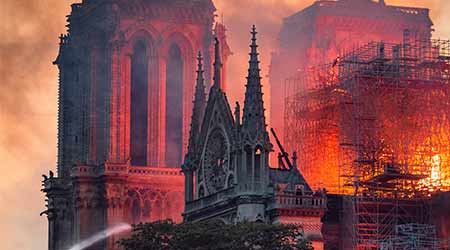« Back to Facilities Management Fire Safety/Protection Category Home
After Fire at Notre Dame, Fire Safety During Construction Takes On New Urgency
April 24, 2019
- Fire Safety/Protection
By Dave Peterson
April 15th, 2019: The day that the Cathedral of Notre Dame burned down in Paris, France. For anyone in this industry watching the live feed, as this more than 800 year old symbol of Paris, an exquisite example of medieval gothic architecture and religious icon, went up in flames, the staging on the roof suggested that the fire was probably caused by construction work.
After any tragedy like this, the codes are reviewed with great fervor and changes are made for the better. This is how the codes evolve and we become safer.
With all of that said, the terrible fire at Notre Dame puts the spotlight on the need to comply with NFPA 241 - 2019. Here are key points that you, the facility manager (owner or owner's representative), needs to know to be successful in complying with NFPA 241 — that is, how to provide fire protection to your facility while under construction, renovation, or demolition.
You — the person in charge of the building, be you the owner or his/her representative — you are referred to in the code as the fire protection program manager (FPPM). It is your responsibility to create a fire protection program for the building during construction, renovation, and even demolition. This is a weighty responsibility and one that will protect not only property, but lives as well. Here is what you have to address:
1. Good Housekeeping
Nothing contributes to fire like an un-kept house. Piles of sawdust, oily rags, and pieces of cut lumber, paper and other refuge need to be tended to and stored or disposed of properly. This includes places to safely dispose of smoking materials f allowed on site.
2. On-Site Security
Nothing is more inviting than an unsecured construction site, from kids playing on machinery and climbing unfinished floors to thieves, arsonists and even the homeless looking for a place to spend the night.
3. Fire Protection System
For construction and renovation, the fire system will need to change as the work progresses (a wireless system is easily reconfigured to keep up with changes during construction) and in demolition, the existing building fire alarm system needs to remain as active as possible until the work is done. There should also be a means of off-site reporting and a schedule of weekly testing and inspection with record retention. Any modification to the system (impairment or otherwise) must be recorded and maintained by you.
4. On-Site Fire Brigade
Who better to act as first responders than those at the scene? Remember that these are not trained firefighters, but knowing how to communicate an alarm to get help on the way and where the fire extinguishers are and how to use them could avert disaster. Fire extinguishers should be dispersed in accordance with criteria in NFPA 10, Standard for Portable Fire Extinguishers.
5. Development of a Pre-Fire Plan
Talk to the fire department, and let them know where the hydrants or sprinkler standpipes are, how to access the building, and where volatile chemical storage (if any) is. They will also need to develop, with you, a place for a command post with building keys, radio, and fire alarm controls. Having all of this ready will this will save time, property, and lives in the event of a fire. Invite the fire department back as the work progresses, access changes, more floors go up, elevators and stairwells get installed, etc. Things change, and they will be grateful for the information. Almost constant communications with the fire services has to be a fact of life. For example, they will want to know where and when dangerous hot works will be performed so that proper detection, fire extinguishers, and even a fire watch can be scheduled. You will find that this will be a requirement in your permitting process.
6. Rapid Communication
Time is of the essence; wasted time could mean lost lives. Make sure everyone knows where to go to communicate a problem and what to listen for indicating a problem in the building. This can be accomplished by radio (walkie talkie), addressable wireless manual alarm activation points placed liberally around the site, and training, training, training.
7. Consideration of Special Hazards Resulting from Previous Occupancies
If you have previous experience as an FPPM, bring your experience to bear and make adjustments when you see familiar pitfalls and obstacles. If this is your first time in this position, then rely on the experience of a mentor and other individuals in the field. You might join an industry association and learn from those who have been there and done that. Learn the code — NFPA 1, 10, 13, 72, 101, 241 and any other building code that affects your work and is applicable in the municipality where the work is being done.
8. Protection of Existing Structures and Equipment from Exposure Fires Resulting from Construction, Alteration, and Demolition Operations
A prime example is the Columbia gas line renovation that took place in Massachusetts in the Fall of 2018 that caused fires and explosion in multiple residences in North Andover, Lawrence, and other towns due to over-pressurization of the gas lines. Although this is not exactly one fire causing another, the domino effect was far reaching.
Of course, this is only an overview of requirements. Get a copy of NFPA 241. It takes a couple of hours to read and years of practice to do right. Your efforts will be rewarded by a friendly fire department, a happy boss, successful construction efforts, and the knowledge that your building will not show up on a live feed in the middle of the day. Most importantly, you will save lives.
David Petersen (dpetersen@tclifesafety.com) is general manager, TC LifeSafety, Inc., a supplier of fire and life safety to the facilities/end user market.








